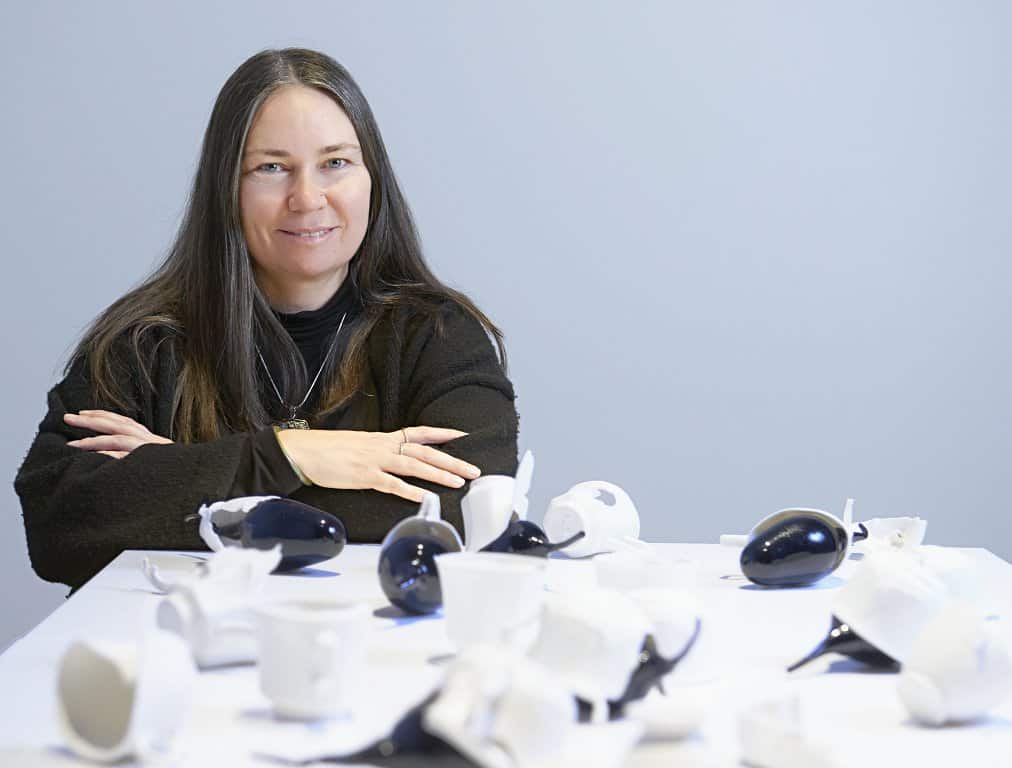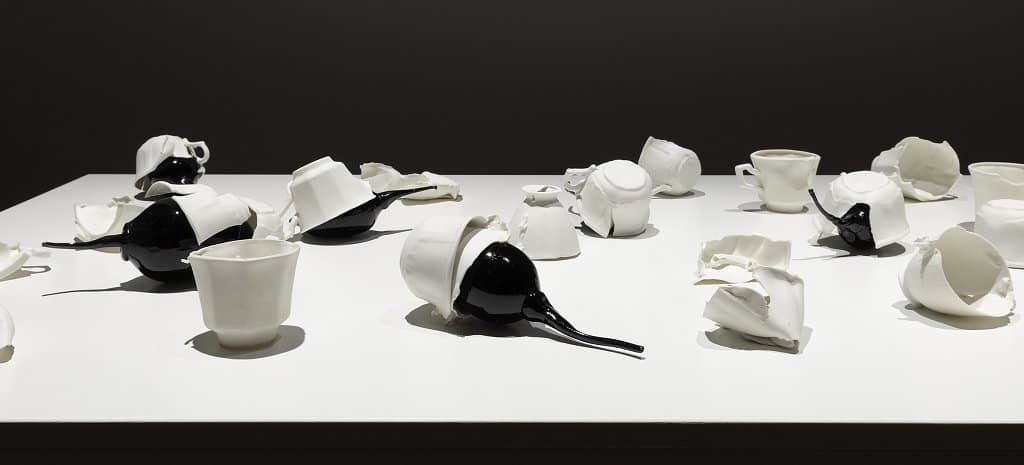- Yhonnie Scarce, Installation view in the 2018 Indigenous Ceramic Award exhibition, Shepparton Art Museum, Photo: Diana Spriggs
- Yhonnie Scarce, Servant and Slave, 2018, porcelain and hand-blown glass dimensions variable courtesy the artist and This Is No Fantasy Dianne Tanzer + Nicola Stein, Melbourne Image: Christian Capurro
The Shepparton Art Museum recently announced the winner of the 2018 Indigenous Ceramic Award as Yhonnie Scarce, for her work, Servant and Slave, 2018.
The work creates a stark depiction of colonisation, as detailed in the catalogue entry by Myles Russell Cook:
For this work, Scarce has, with Jordan Wood, used bleached white porcelain to create a collection of handmade Edwardian-style teacups. Each of the cups is cracked, fused and twisted. The damage to the cups’ surfaces references the emotional and physical scarring that occurred to Aboriginal women working in domestic service throughout the nineteenth, and well into the twentieth century.
This series of damaged cups is representative of both psychological and physical trauma, echoing the experiences of generations of women who have endured legacies of violence. Inside a small number of cups grow modest and unobtrusive black glass bush bananas. The bush bananas appear as if they are splitting and fracturing the ceramic by creating pressure from within. The viewer reads the installation as a temporal moment, the empty cups like empty cocoons or the shells of cicadas that have flown away. Each bush banana grows like a larva inside its cup, until eventually the cup is split and the grub revealed. The reference to that which grows inside us is undoubtedly a metaphor for the continuing strength of women, and the spirit of aunties, grandmothers, mothers, sisters and Ancestors passed.
The $20,000 Indigenous Ceramic Award (ICA) is the most prestigious national award for Indigenous ceramics, showcasing new and exciting developments in the field. The acquisitive prize attracted ceramic works from Indigenous artists across Australia.
The winning work, and that of the finalists, will be on display at SAM from 25 August to 11 November 2018.
Judges shortlisted seven artists from a wide field of contemporary Indigenous artists working in the ceramics medium. Their approaches highlighted the rich and diverse ways that artists understand and extend the possibilities of the medium of ceramics within our contemporary context and times.
The 2018 finalists are:
Dean Cross (Worimi, ACT): Cross presents a site-specific work that is responsive to the architecture that confines it and will continue to respond directly to the situation it is presented in. Cross’ work seeks to challenge the Western canon of memorial statuary.
Jackie Wirramanda (Wergaia, VIC): Wirramanda’s work incorporates the colours of Lake Tyrell, a site which is both locally and culturally significant to the artist; it is a place referred to by the old people as one where the earth met the heavens. The work represents the Creation story of Larnankurrk (seven sisters) of Wergaia area.
Jan Goongaja Griffiths (Miriwoonga/Ngarinyman, WA): Goongaja Griffiths’ work presents scenes from her family history, including her father’s experience as an Indigenous stockman working for rations at Victoria River Station, NT in the 1940s. The work continues in her practice of creating small figurines.
Janet Fieldhouse (Torres Strait Islands, QLD): Fieldhouse, who is participating in her fifth Award, presents large scale sculptural forms, exploring themes such as the narrative of storytelling, abstract scarification, the beauty of landscapes, and sharing of knowledge.
Jock Puautjimi (Tiwi, NT): Puautjimi presents lidded and unlidded vase forms which continue to explore Tiwi graphic mark making. Some lids have symbolic sculptural pieces affixed. Puautijimi also presents representations of traditional pukamani poles.
Penny Evans (Gamilaraay/Gomeroi, NSW): Evans’s pieces work with Thanggall and Giinbay (large and small freshwater mussel) ceramic forms, utilising terracotta, black and white clays.
Yhonnie Scarce (Kokatha/Nukunu, SA): Scarce’s work combines her signature glass vessels with ceramic forms, making reference to the oppressive behaviours that occurred during Aboriginal domestic’s employment, and how Aboriginal women were kept; hidden, covered and imprisoned.



